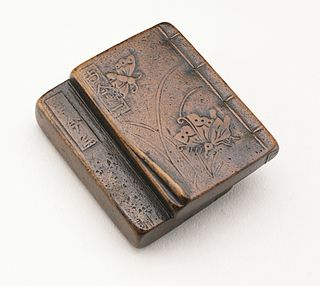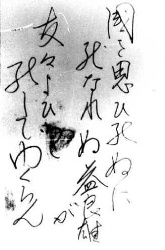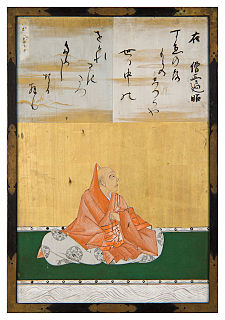 W
WJapanese poetry is poetry typical of Japan, or written, spoken, or chanted in the Japanese language, which includes Old Japanese, Early Middle Japanese, Late Middle Japanese, and Modern Japanese, as well as poetry in Japan which was written in the Chinese language or ryūka from the Okinawa Islands: it is possible to make a more accurate distinction between Japanese poetry written in Japan or by Japanese people in other languages versus that written in the Japanese language by speaking of Japanese-language poetry. Much of the literary record of Japanese poetry begins when Japanese poets encountered Chinese poetry during the Tang dynasty. Under the influence of the Chinese poets of this era Japanese began to compose poetry in Chinese kanshi); and, as part of this tradition, poetry in Japan tended to be intimately associated with pictorial painting, partly because of the influence of Chinese arts, and the tradition of the use of ink and brush for both writing and drawing. It took several hundred years to digest the foreign impact and make it an integral part of Japanese culture and to merge this kanshi poetry into a Japanese language literary tradition, and then later to develop the diversity of unique poetic forms of native poetry, such as waka, haikai, and other more Japanese poetic specialties. For example, in the Tale of Genji both kanshi and waka are frequently mentioned. The history of Japanese poetry goes from an early semi-historical/mythological phase, through the early Old Japanese literature inclusions, just before the Nara period, the Nara period itself, the Heian period, the Kamakura period, and so on, up through the poetically important Edo period and modern times; however, the history of poetry often is different from socio-political history.
 W
WThe Bussokuseki-kahi (仏足石歌碑) is a well-known monument in the Yakushi Temple in Nara, consisting of a traditional Buddha footprint inscribed with twenty-one poems, known as bussokusekika.
 W
WThe death poem is a genre of poetry that developed in the literary traditions of East Asian cultures—most prominently in Japan as well as certain periods of Chinese history and Joseon Korea. They tend to offer a reflection on death—both in general and concerning the imminent death of the author—that is often coupled with a meaningful observation on life. The practice of writing a death poem has its origins in Zen Buddhism. It is a concept or worldview derived from the Buddhist teaching of the three marks of existence , specifically that the material world is transient and impermanent , that attachment to it causes suffering , and ultimately all reality is an emptiness or absence of self-nature . These poems became associated with the literate, spiritual, and ruling segments of society, as they were customarily composed by a poet, warrior, nobleman, or Buddhist monk.
 W
WHaiku is a type of short form poetry originally from Japan. Traditional Japanese haiku consist of three phrases that contain a kireji, or "cutting word", 17 on in a 5, 7, 5 pattern, and a kigo, or seasonal reference. Similar poems that do not adhere to these rules are generally classified as senryū.
 W
WMurasaki Shikibu was a Japanese novelist, poet and lady-in-waiting at the Imperial court in the Heian period. She is best known as the author of The Tale of Genji, widely considered to be one of the world's first novels, written in Japanese between about 1000 and 1012. Murasaki Shikibu is a descriptive name; her personal name is unknown, but she may have been Fujiwara no Kaoriko , who was mentioned in a 1007 court diary as an imperial lady-in-waiting.
 W
WKigo is a word or phrase associated with a particular season, used in traditional forms of Japanese poetry. Kigo are used in the collaborative linked-verse forms renga and renku, as well as in haiku, to indicate the season referred to in the stanza. They are valuable in providing economy of expression.
 W
WKyōka is a popular, parodic subgenre of the tanka form of Japanese poetry with a metre of 5-7-5-7-7. The form flourished during the Edo period and reached its zenith during the Tenmei era (1781–89).
 W
WThe term "National Treasure" has been used in Japan to denote cultural properties since 1897, although the definition and the criteria have changed since the introduction of the term. The written materials in the list adhere to the current definition, and have been designated National Treasures according to the Law for the Protection of Cultural Properties that came into effect on June 9, 1951. The items are selected by the Ministry of Education, Culture, Sports, Science and Technology based on their "especially high historical or artistic value".
 W
WMyōjō was a monthly literary magazine published in Japan between April 1900 and November 1908. The name Myōjō can be translated as either Bright Star or Morning Star.
 W
WPoetic diary or Nikki bungaku (日記文学) is a Japanese literary genre, dating back to Ki no Tsurayuki's Tosa Nikki, compiled in roughly 935. Nikki bungaku is a genre including prominent works such as the Tosa Nikki, Kagerō Nikki, and Murasaki Shikibu Nikki. While diaries began as records imitating daily logs kept by Chinese government officials, private and literary diaries emerged and flourished during the Heian period.
 W
WThe Rokkasen are six Japanese poets of the mid-ninth century who were named by Ki no Tsurayuki in the kana and mana prefaces to the poetry anthology Kokin wakashū as notable poets of the generation before its compilers.
 W
WRyūka is a genre of songs and poetry originating from the Okinawa Islands, Okinawa Prefecture of southwestern Japan. Most ryūka are featured by the 8-8-8-6 syllable structure.
 W
WShigin is a performance of reciting a Japanese poem or a Chinese poem read in Japanese, each poem usually chanted by an individual or in a group. Reciting can be done loudly before a large audience, softly to a few friends, or quietly to the reciter themselves.
 W
WThe Three perfections is the gathering of poets, calligraphers and painters to create an artwork in ancient China and Japan. The resulting product would be a painting that would include the work of a calligrapher to write a poem.
 W
WUta-awase , poetry contests or waka matches, are a distinctive feature of the Japanese literary landscape from the Heian period. Significant to the development of Japanese poetics, the origin of group composition such as renga, and a stimulus to approaching waka as a unified sequence and not only as individual units, the lasting importance of the poetic output of these occasions may be measured also from their contribution to the imperial anthologies: 92 poems of the Kokinshū and 373 of the Shin Kokinshū were drawn from uta-awase.
 W
WWaka is a type of poetry in classical Japanese literature. Although waka in modern Japanese is written as 和歌, in the past it was also written as 倭歌, and a variant name is yamato-uta (大和歌).
 W
WWinter Days is a 2003 Japanese anime film directed by Kihachirō Kawamoto. It is based on one of the renku in the 1684 collection of the same name by the 17th-century Japanese poet Bashō.